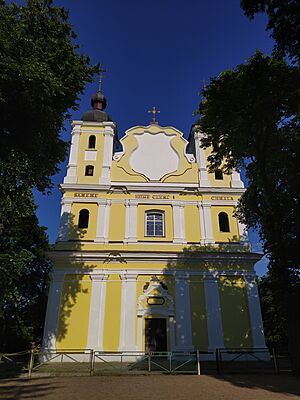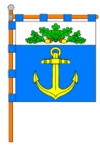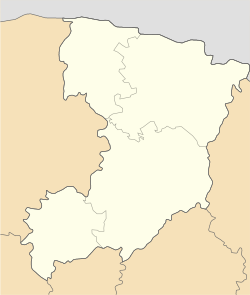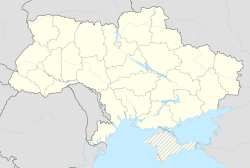Dubrovytsia facts for kids
Quick facts for kids
Dubrovytsia
Дубровиця
|
|||
|---|---|---|---|

A catholic church in Dubrovytsia
|
|||
|
|||
| Country | |||
| Oblast | Rivne Oblast | ||
| Raion | Sarny Raion | ||
| Hromada | Dubrovytsia urban hromada | ||
| Area | |||
| • Total | 58.7 km2 (22.7 sq mi) | ||
| Population
(2022)
|
|||
| • Total | 9,343 | ||
| Postal Code |
34100—34108
|
||
| Area code(s) | +380-3658 | ||
Dubrovytsia (Ukrainian: Дубровиця) is a city in Rivne Oblast, Ukraine. It used to be the main town of Dubrovytsia Raion until 2020. The city is also known for its historical Jewish community. About 9,343 people lived there in 2022.
Some important old buildings in Dubrovytsia include a beautiful Roman Catholic church. It was built in 1740. There are also two Orthodox churches. One was built in 1861 and another in 1872. Before World War II, the city also had three synagogues, which are Jewish places of worship.
Contents
History of Dubrovytsia
Dubrovytsia is now part of Rivne Oblast. But long ago, it was part of a different region called the Land of Brest. It was not until 1805 that it became part of the Russian Empire's Volhynian region. This happened along with many other areas that used to be part of Poland.
In the 1800s, Dubrovytsia was an important trading town. It had many factories that made goods for people living nearby. There was also a special school run by Piarist monks. This school was started in 1695. Even though the monks' group closed in 1832, the school stayed open. It finally closed in 1939 when Soviet authorities took over the area. Famous people like Cyprian Godebski and Alojzy Feliński went to this school.
During World War I and the years right after, the town was controlled by many different groups. These included the Russian army, the Polish army, local groups, and Ukrainian forces. The German army also took control for a while.
In September 1939, the Soviet Union took over the town. This was part of an agreement with Germany called the Molotov–Ribbentrop Pact.
The Jewish Community in Dubrovytsia
A large Jewish community lived in the center of Dubrovytsia. This area was known as the Dombrovitza shtetl. Jewish families owned many of the stores and houses. They also owned timber cutting factories, which was a big business in the area.
Challenges During World War I
In 1915, many Jewish refugees and soldiers came to Dubrovytsia. The synagogues were used to help house them. Later, a Polish army division stayed in town. They forced some Jewish families out of their homes.
During the Russian Revolution, some people wrongly accused the Jews of supporting the communists. This caused problems for the Jewish community.
In March 1918, some Polish soldiers attacked Jewish people in villages near Dubrovytsia. The Jews in Dubrovytsia formed a self-defense group. They used a bomb to stop a planned attack in the town square. A German army unit later took control of the town.
In 1920, Jewish people faced more difficulties. The town changed hands many times between Russian and Polish forces. In October 1920, a militia attacked Jewish people in a nearby village. However, a Polish major and his army protected the Jews in Dubrovytsia.
In 1937, on a Jewish holiday, the Polish authorities made Jewish residents paint their houses and fix fences very quickly. Some poorer Jewish people were treated badly.
World War II and the Holocaust
In September 1939, when the Soviets took over, many refugees came to Dubrovytsia. Jewish and Christian refugees were helped equally in the Jewish learning house.
During World War II, the Jewish people of Dubrovytsia faced terrible events. When the town came under German-supported Ukrainian rule, Jews were forced into hard labor. Their property and belongings were taken from them. A Jewish council, called a Judenrat, was set up. A special area, called a Ghetto, was created for Jews. They were forced to give up large amounts of gold, fur, and shoes. Food for Jews was severely limited.
Around April 1942, a Ghetto was formally established for the 4,327 Jews in the town. Jews from nearby villages were also forced into this Ghetto. The main synagogue was closed, and public prayers were not allowed.
Jewish police guarded the Ghetto. There were tensions between the Jewish council and the Jewish population. Experts were sent to the town to make sure the Jewish population followed German orders without resisting.
The Ghetto's End
A notice told all Jews to gather at the cemetery on a Jewish holiday. The main synagogue was opened for prayer on the first day of the holiday. A Jewish speaker explained it was only for a head count. The Jews were sent home.
In the last three months of the Ghetto, signs were put up claiming Jews had poisoned wells. Other posters called for harm against Jews. A Ukrainian militia unit in Dubrovytsia had taken part in attacks on Jews in other places.
Survivors and Resistance
Some Jewish people from Dubrovytsia survived by hiding in the forests. Seventeen of them later reached Israel and shared their stories.
Local farmers sometimes told the Germans where Jewish people were hiding in the forests. They did this for small rewards.
Ten Jewish survivors formed a small group in the nearby swamp area. They found weapons and used them to get more guns. They carried out raids at night. This made the Germans think a large armed Jewish group was nearby. They also warned local people not to help the Germans find Jewish refugees. After some fighting, German troops avoided entering the town.
Ukrainian militia attacked any local people who helped Jews. There are many reports of local Ukrainians harming Jewish refugees who asked for help.
By March 1944, the Russian army took control of the region. Many Jewish survivors decided not to return to Dubrovytsia. They did not want to meet their neighbors who had been hostile. Instead, about 200 Jewish refugees gathered in Refaowka, a former Jewish town where all the Jews had been killed. They began to rebuild their Jewish life there.
The famous writer Ilya Ehrenburg visited Dubrovytsia. He wrote about what he learned from the locals. He did not meet the Jewish survivors from the town.
Notable People
- Georges Charpak, who won a Nobel Prize in Physics, was born in Dubrovytsia in 1924.
See also
 In Spanish: Dubrovytsya para niños
In Spanish: Dubrovytsya para niños








